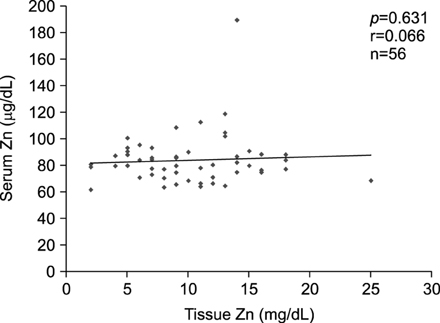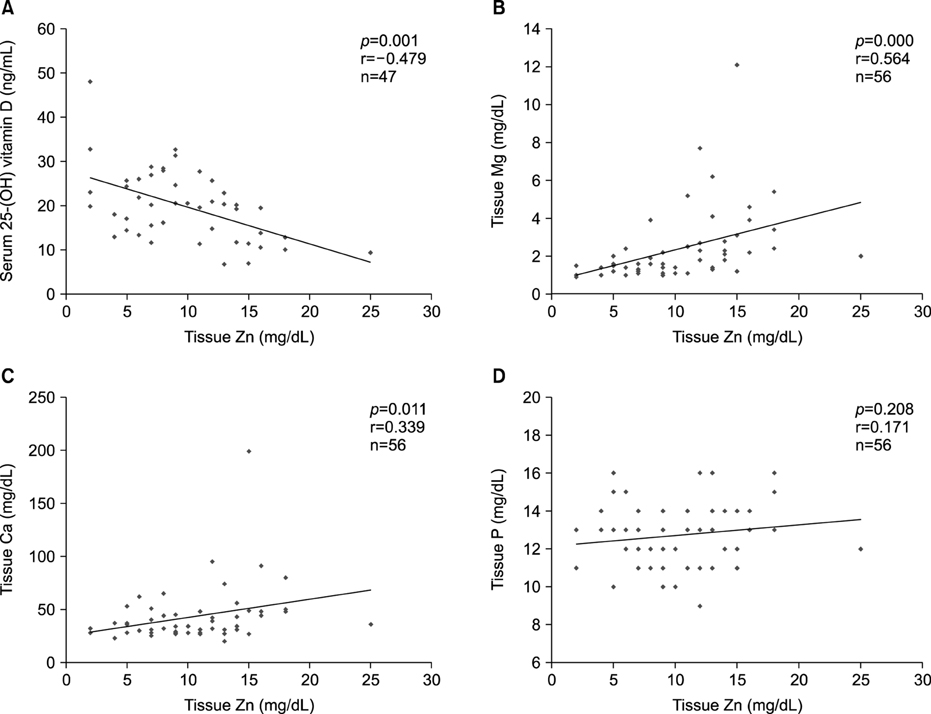Pediatr Gastroenterol Hepatol Nutr.
2016 Dec;19(4):259-268. 10.5223/pghn.2016.19.4.259.
Hair Zinc Level Analysis and Correlative Micronutrients in Children Presenting with Malnutrition and Poor Growth
- Affiliations
-
- 1Department of Pediatrics, Hanyang University College of Medicine, Seoul, Korea. kyjoo@hanyang.ac.kr
- KMID: 2364767
- DOI: http://doi.org/10.5223/pghn.2016.19.4.259
Abstract
- PURPOSE
Zinc deficiency can induce serious clinical problems in the gastrointestinal (GI) system and immune system and can affect growth and development. It is more severe in younger patients. Chronic zinc deficiency is reflected more precisely in hair than in serum. We studied hair zinc levels and other hair and serum micronutrients in chronic malnourished children to identify which micronutrients are affected or correlated with the other ones.
METHODS
Hair mineral analyses were performed in 56 children (age, 1-15 years) presenting with malnutrition, poor growth, poor appetite, anorexia, with/without other GI symptoms (diarrhea, abdominal pain, constipation) from August 2012 to March 2015. Biochemical studies for macronutrients and major micronutrients were also conducted.
RESULTS
Hair zinc deficiency was diagnosed in 88%, and serum zinc deficiency was diagnosed in 55% of the children. There was no statistical correlation between serum and tissue zinc level. Hair zinc levels were highly correlated with serum vitamin D (r=−0.479, p=0.001), which also showed correlation with hair levels of magnesium and calcium. (r=0.564, 0.339, p=0.001, 0.011). Hair calcium level was correlated with serum pre-albumin (r=0.423, p=0.001). These correlations may explain the phenomenon that the major clinical manifestation of zinc deficiency is poor body growth. Clinical symptoms were resolved in most children after zinc supplementation.
CONCLUSION
Hair zinc and mineral analyses are useful as a therapeutic guide in the clinical investigation of children with malnutrition and poor growth.
Keyword
MeSH Terms
Figure
Cited by 1 articles
-
Analysis of health habit and hair mineral nutrition status of media addicted adolescent
Hee-Sook Lim, Soon-Kyung Kim
J Nutr Health. 2018;51(4):295-306. doi: 10.4163/jnh.2018.51.4.295.
Reference
-
1. World Health Organization (WHO). Nutrition for health and development: a global agenda for combating malnutrition [Internet]. France: WHO;2000. cited 2016 Aug 9. Available from: http://apps.who.int/iris/bitstream/10665/66509/1/WHO_NHD_00.6.pdf.2. Hendricks KM, Duggan C, Gallagher L, Carlin AC, Richardson DS, Collier SB, et al. Malnutrition in hospitalized pediatric patients. Current prevalence. Arch Pediatr Adolesc Med. 1995; 149:1118–1122.3. Mehta NM, Corkins MR, Lyman B, Malone A, Goday PS, Carney LN, et al. Defining pediatric malnutrition: a paradigm shift toward etiology-related definitions. JPEN J Parenter Enteral Nutr. 2013; 37:460–481.4. Cousins RJ. Zinc. In : Bowman BAB, Russell RM, editors. Present knowledge in nutrition. Washington, DC: ILSI Press;2006. p. 445–457.5. King JC. Zinc. In : Shils ME, Shike M, editors. Modern nutrition in health and disease. 10th ed. Philadelphia: Lippincott Williams & Wilkins;2006. p. 271–285.6. King JC, Shames DM, Woodhouse LR. Zinc homeostasis in humans. J Nutr. 2000; 130:5S Suppl. 1360S–1366S.
Article7. Tapiero H, Tew KD. Trace elements in human physiology and pathology: zinc and metallothioneins. Biomed Pharmacother. 2003; 57:399–411.
Article8. Maret W, Sandstead HH. Zinc requirements and the risks and benefits of zinc supplementation. J Trace Elem Med Biol. 2006; 20:3–18.
Article9. Wołowiec P, Michalak I, Chojnacka K, Mikulewicz M. Hair analysis in health assessment. Clin Chim Acta. 2013; 419:139–171.
Article10. Brown KH, Wuehler SE, Peerson JM. The importance of zinc in human nutrition and estimation of the global prevalence of zinc deficiency. Food Nutr Bull. 2001; 22:113–125.
Article11. Korea Centers for Disease Control and Prevention. Growth charts [Internet]. Cheongju: Korea Centers for Disease Control and Prevention;2007. cited 2016 Sep 13. Available from: http://cdc.go.kr/CDC/cms/cmsFile-Download.jsp?fid=28&cid=1235&fieldName=attachGrp&index=1.12. Miekeley N, de Fortes Carvalho LM, Porto da Silveira CL, Lima MB. Elemental anomalies in hair as indicators of endocrinologic pathologies and deficiencies in calcium and bone metabolism. J Trace Elem Med Biol. 2001; 15:46–55.
Article13. Allen LH. Nutritional influences on linear growth: ageneral review. Eur J Clin Nutr. 1994; 48:Suppl 1. S75–S89.14. Gibson RS, Hotz C. Martorell R, Haschke F, editors. Nutrition and growth. Philadelphia: Nestec Inc, Vevey/Lippincott, Williams & Wilkins;2001. p. 159–192.15. Brown KH, Peerson JM, Rivera J, Allen LH. Effect of supplemental zinc on the growth and serum zinc concentrations of prepubertal children: a meta-analysis of randomized controlled trials. Am J Clin Nutr. 2002; 75:1062–1071.
Article16. Estívariz CF, Ziegler TR. Nutrition and the insulin-like growth factor system. Endocrine. 1997; 7:65–71.
Article17. Abrams SA. Nutritional rickets: an old disease returns. Nutr Rev. 2002; 60:111–115.
Article18. Clausen T, Dørup I. Micronutrients, minerals and growth control. Bibl Nutr Dieta. 1998; (54):84–92.
Article19. Lawless JW, Latham MC, Stephenson LS, Kinoti SN, Pertet AM. Iron supplementation improves appetite and growth in anemic Kenyan primary school children. J Nutr. 1994; 124:645–654.
Article20. Rivera J, Martorell R. Nutrition, infection and growth. Part 1: effects of infection on growth. Clin Nutr. 1988; 7:156–162.21. Dørup I, Clausen T. Effects of magnesium and zinc deficiencies on growth and protein synthesis in skeletal muscle and the heart. Br J Nutr. 1991; 66:493–504.
Article22. Nishi Y. Zinc and growth. J Am Coll Nutr. 1996; 15:340–344.
Article23. Loveridge N, Noble BS. Control of longitudinal growth: the role of nutrition. Eur J Clin Nutr. 1994; 48:75–84.24. da Silva-Santana SC, da Silva Diniz A, de Feitas Lola MM, Oliveira RS, Silva SMM, de Oliveira SF, et al. Parameters of evaluation of zinc nutritional status: comparison between zinc hair rates and serum alkaline phosphatase in pre-scholars of the Municipality of João Pessoa, Paraíba. Rev Bras Saúde Mater Infant. 2002; 2:275–282.
Article25. O'Dell BL, Reeves PG. Zinc status and food intake. In : Mills CF, editor. Zinc in human biology. London: Springer-Verlag;1989. p. 173–181.26. Cousins RJ. Systemic transport of zinc. In : Mills CF, editor. Zinc in human biology. New York: Springer-Verlag;1989. p. 79–93.27. King JC. Zinc: an essential but elusive nutrient. Am J Clin Nutr. 2011; 94:679S–684S.
Article28. Delves HT. Assessment of trace element status. Clin Endocrinol Metab. 1985; 14:725–760.29. Baumslag N, Yeager D, Levin L, Petering HG. Trace metal content of maternal and neonate hair. Zinc, copper, iron, and lead. Arch Environ Health. 1974; 29:186–191.30. Petering HG, Yeager DW, Witherup SO. Trace metal content of hair. II. Cadmium and lead of human hair in relation to age and sex. Arch Environ Health. 1973; 27:327–330.31. Son BS, Hong EJ, Kim YS. A study on trace metal levels in hair. Korean Ind Hyg Assoc J. 1997; 7:233–244.32. Hong J, Lee JH, Lee R, Shin JY, Ko JS, Seo JK. Trace elements deficiency and the diagnostic usefulness of hair mineral analysis in children with chronic gastrointestinal disease. Korean J Pediatr Gastroenterol Nutr. 2008; 11:122–129.
Article33. Watts DL. The nutritional relationships of zinc. J Orthomol Med. 1988; 3:63–67.34. Bohn T. Dietary factors influencing magnesium absorption in humans. Curr Nutr Food Sci. 2008; 4:53–72.
Article35. Hardwick LL, Jones MR, Brautbar N, Lee DB. Site and mechanism of intestinal magnesium absorption. Miner Electrolyte Metab. 1990; 16:174–180.36. Hambidge KM, Miller LV, Tran CD, Krebs NF. Measurements of zinc absorption: application and interpretation in research designed to improve human zinc nutriture. Int J Vitam Nutr Res. 2005; 75:385–393.
Article37. Oberleas D, Muhrer ME, O'Dell BL. Dietary metal-complexing agents and zinc availability in the rat. J Nutr. 1966; 90:56–62.
Article38. McKenna AA, Ilich JZ, Andon MB, Wang C, Matkovic V. Zinc balance in adolescent females consuming a lowor high-calcium diet. Am J Clin Nutr. 1997; 65:1460–1464.39. Wood RJ, Zheng JJ. High dietary calcium intakes reduce zinc absorption and balance in humans. Am J Clin Nutr. 1997; 65:1803–1809.
Article40. Yanagisawa H. Zinc deficiency and clinical practice--validity of zinc preparations. Yakugaku Zasshi. 2008; 128:333–339.
Article
- Full Text Links
- Actions
-
Cited
- CITED
-
- Close
- Share
- Similar articles
-
- Therapeutic Iron and Zinc Supplementation in Children
- Essential micronutrients in children and adolescents with a focus on growth and development: a narrative review
- A Case of Protein Energy Malnutrition After Whipples' s Operation
- Effect of Zinc Administration on the Autistic Children
- The Association of Hair Zinc with Metabolic Risk Factors for Selected Women in Korea




